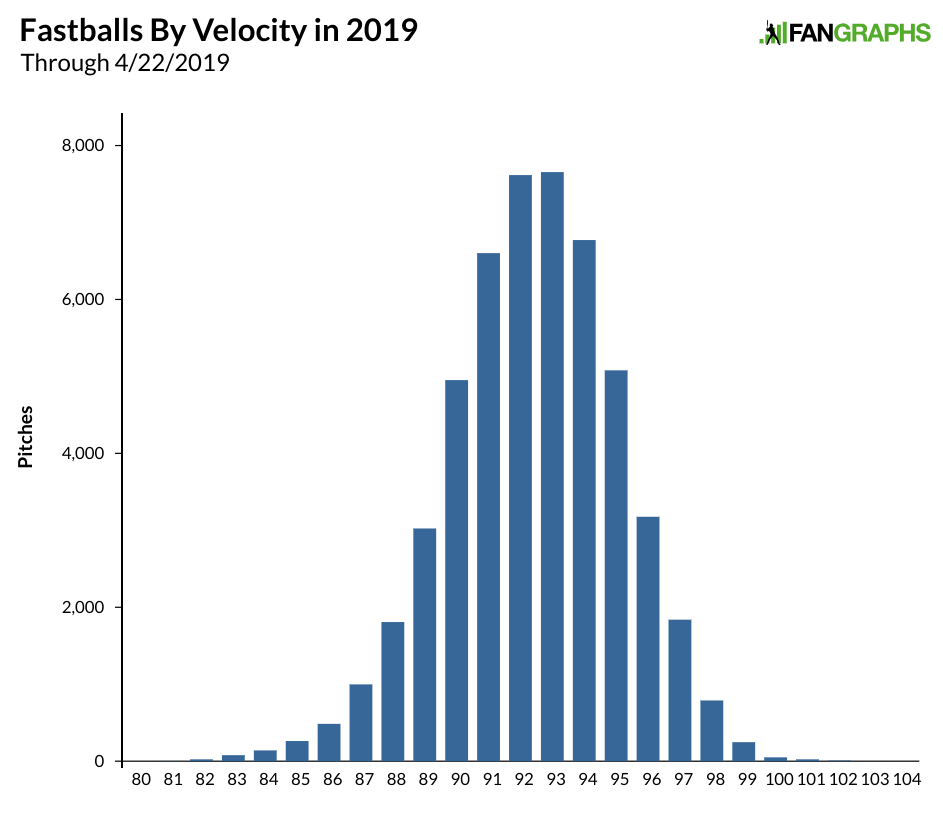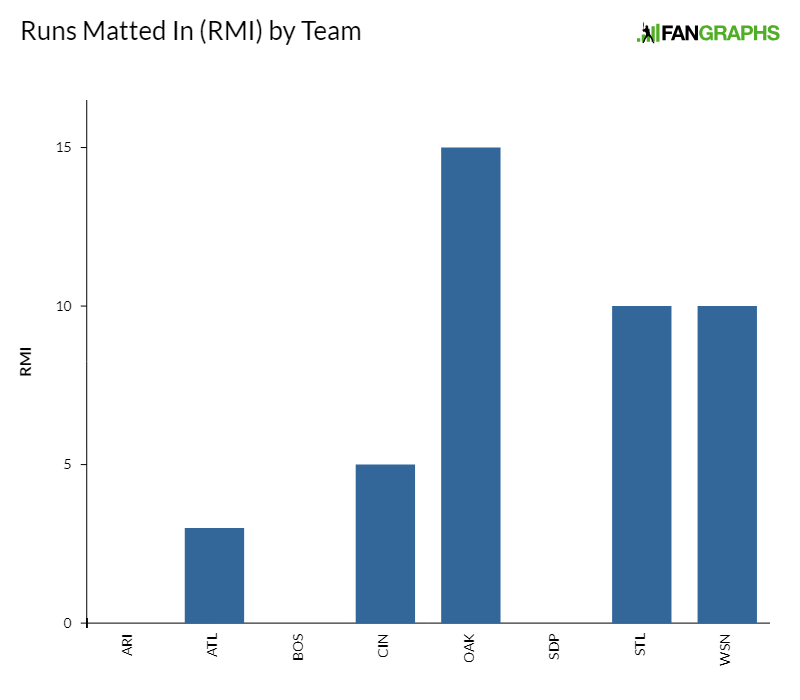Baseball is a game of failure, forcing players to find, utilize, and ultimately rely on their strengths. It is hard to find someone who exemplifies that more than Rick Ankiel. He pitched for the Cardinals in 2000 and was so good that he finished second in Rookie of the Year voting. Then the NLDS came along and Ankiel could not throw strikes. He gave up four runs on two hits, four walks, and five wild pitches. It could have been a fluke, just the nerves of his first postseason appearance, pitching against Greg Maddux, no less. Totally understandable, except he could not get through the first inning of his next start. It was the second game of the NLCS and Ankiel was pulled after twenty pitches, five of which went to the backstop.
Things never got much better. In 2001, he threw 24 major league innings and walked 25 batters. He was demoted all the way to Rookie League that year, sat out the 2002 season, then had Tommy John surgery in 2003. He returned as a reliever in 2004 and posted a 4.75 FIP in ten innings. Things were bleak until the Cardinals offered to play him at a different position. Rick Ankiel came back in 2007 as an outfielder and he was good! He was known for making unbelievable throws, but also managed to hit 74 home runs during his seven seasons. Not bad for a former pitcher. He retired after the 2013 season, having made a comeback for the ages.
And he wants to do it again.
Rick Ankiel is working to return to the majors as a left-handed reliever at age 39. He played in one game during the Bluegrass World Series last year, where he racked up two hits and four RBI in four plate appearances, not to mention that he threw out a runner at the plate. But then, he did the one thing few people ever thought he would do again: he took the mound. He only faced one batter, but he struck him out on four pitches. It was enough for Ankiel to wonder whether he could get a chance to once again experience the game from at the position that had been so cruel to him.
All of this is bananas. The astonishingly quick rise and then fall from pitching stardom. Reinventing himself as an outfielder. Succeeding in the major leagues for seven seasons after contemplating retirement. As if that was not challenging enough, last October Rick Ankiel had an ulnar collateral ligament repair with internal brace construction. A UCL tear generally results in Tommy John surgery, which has a 12 to 18 month recovery time. If Ankiel had required another Tommy John, any potential comeback would have been pushed into his age-40 season and, as he mentioned on a recent Cardinals spring training broadcast, likely would not have happened at all. “If it had been a total reconstruction, he said, “I probably would’ve passed and just moved on. I would’ve missed all this year and then we’re all the way to next spring training and that’s just a long time.” When I heard Ankiel’s interview, I wondered whether primary repair surgery would help or hinder his comeback effort, and went searching for an answer.
Primary repair surgery is still fairly new. The first major league pitcher to have it was Seth Maness during the 2016 season. There is very little data about how it compares to Tommy John and not all UCL tears are eligible for primary repair. If a ligament is torn in the middle, a player will require Tommy John which involves creating a new ligament out of tissue taken from another part of the body. If it is torn near the bone, however, primary repair comes into play. It involves minor repairs and providing a sort of abutment around where the ligament is anchored to the bone. The recovery timeline ranges from seven to nine months, or nearly half of what it takes to rehab from the Tommy John procedure.
Seth Maness is the only case study I could find at the major league level. He is not a one-to-one comparison, since his arm had gone through about four major league seasons while Ankiel’s played somewhere around nine. Given Ankiel’s 2003 Tommy John, his surgeon actually repaired a reconstructed ligament. There are a lot of questions and variables to consider.
First, let’s take a look at Maness’s numbers before and after his surgery. He hit the “dead arm” phase in 2016, so the data below includes the 2014 and 2015 seasons, plus the 2017 season following his surgery, which would parallel Ankiel’s planned return. The sample size from the major leagues in 2017 is small, so our conclusions will rely heavily on Maness’s time with the Royals’ Triple-A affiliate.
Seth Maness Pre- and Post-Primary Repair
| Season |
IP |
K/9 |
BB/9 |
AVG |
FIP |
GB% |
FB% |
Pull% |
Oppo% |
| 2014 |
80.1 |
6.16 |
1.23 |
.253 |
3.38 |
56.0% |
25.1% |
37.8% |
26.9% |
| 2015 |
63.1 |
6.54 |
1.85 |
.301 |
3.78 |
55.9% |
25.0% |
37.6% |
22.9% |
| 2017 (MLB) |
9.2 |
3.72 |
1.86 |
.372 |
6.99 |
51.3% |
23.1% |
38.5% |
20.5% |
| 2017 (AAA) |
47.0 |
6.70 |
1.53 |
.318 |
4.74 |
47.2% |
34.6% |
37.4% |
31.9% |
The first thing that pops out are the consistencies. Maness’s strikeout rate in the minor leagues was consistent with what it had been during the 2014 and 2015 seasons. Hitters continued to pull the ball at the same rate, and the number of walks he issued was fairly similar as well. These are good signs.
However, Maness relied heavily on groundballs for his success. It felt like every time he was on the mound, he would induce a double-play. His groundball percentage dropped significantly, 4% in the majors and 9% in the minors. Naturally, his flyball rate jumped, rising to 9% in the minor leagues. His FIP jumped an entire point from 2015 to 2017, as he relied increasingly on the defense behind him. He also lost about two miles per hour on his sinker, slider, and fastball during the 2016 season. He never regained that velocity. If Ankiel wants to be major-league ready, he will need one of these secondary pitches. Can he avoid the slowdown that plagued Seth Maness? Only time will tell.
Maness was released by the Royals in 2018 and currently plays in the Atlantic League. He never quite regained the effectiveness he had prior to the injury. That said, it does not spell disaster for Rick Ankiel.
First, Ankiel relied more on strikeouts than groundballs, which may surprise some given his difficulty throwing strikes. While the outcome Maness relied on took a hit, his strikeout rate held fairly steady. His ability to put the ball in the zone was not impacted, which is obviously great news for Rick Ankiel. Second, Maness relied most heavily on his sinker, then fell back on his changeup or fastball when needed. Ankiel has said he would rely on a curveball and high fastball. Maness did not have a curveball so there is no available data to compare. As for the fastball, there was a dip in velocity which is cause for concern.
Things are looking up since Ankiel hit 89 mph in the Bluegrass World Series last year when he was not even “in pitching shape.” That outing, such as it was, also occurred before the primary repair surgery, so the ligament was weakened. That velocity tops Maness’ fastball average at 88 MPH in 2017. However, because Ankiel has historically been more reliant on this pitch, he will need to achieve a significant uptick in velocity (or undergo a significant change to his repertoire) in order to compete, especially because he wants to compete not only in the minor leagues as Maness did, but in the majors.
Finally, though it is difficult to isolate the surgery’s effect, it did not appear to increase the rate at which Maness walked hitters. He was not suddenly wild, nor did his control evaporate. After the onset of the yips, Ankiel could rarely throw strikes. If he has overcome the anxiety, which he says he has, then it all comes down to his ability to control the location of his pitches. Can he do that as effectively as he did in 2000? The answer is yet to be determined, but using Seth Maness as a case study indicates that the primary repair surgery may not necessarily be what undermines Ankiel’s pitch control.
The only narrative in sports that is better than a comeback story is a second comeback. It’s something fans tend to root for. The first time he was challenged in this sport, Ankiel’s solution was to climb a different mountain, and conquer the outfield instead of the pitching mound. This time, things will likely be harder. There are many questions yet to be answered, questions that we would have even without the additional red flag of a surgery. The chances here are remote. Could this be the year he overcomes the very problem that hindered him in the first place? That remains to be seen, but Seth Maness provides a hopeful if narrow blueprint for Rick Ankiel’s return to the major leagues, or at least, he offers a limited answer on one important part of Ankiel’s journey that could hold him back. I sure hope he makes it.


